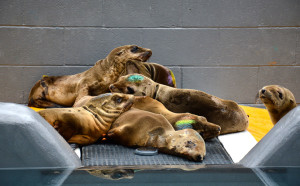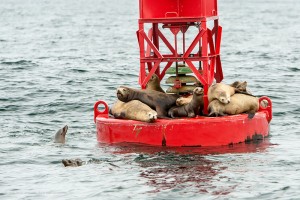At the new Marine Mammal Center overlooking Rodeo Lagoon in the Marin Headlands, I watched a lab technician begin a post-mortem on a sea lion pup. From an overhead viewing platform that is open to the public, I watched her measure the length of the emaciated pup, roll it from side to side to look for lesions, and pull what looked like a worm out of its anus.
A necropsy is a normal procedure at most marine mammal hospitals; what isn’t normal is being able to witness it. Incorporating public viewing of their pools and labs was an integral part of the redesign of this $32-million facility that opened on June 15. By allowing such access, center staff hope that visitors will become educated about the causes of marine mammal sickness and death–from toxicity to fishing line entanglements to plastic pollution–and will then be inspired to examine how their own daily life choices can affect the ocean and marine life.
In the brand-new pools viewed from an outdoor observation deck, Pacific harbor seal pups whined like babies. They are so adorable it’s easy to forget these are wild animals that are here because they’re sick. (Nearly half of the center’s patients when I visited were harbor seal pups, many of them in the hospital because well-meaning citizens tried to rescue them. It’s against the law and never a good idea to touch or approach a marine mammal; call the center instead.)
Last year, the Marine Mammal Center rescued 816 animals, and over 50 percent recovered. Those that die are given a post-mortem, with blood, tissue, and serum samples catalogued and stored in a tissue bank housed on-site in one of the former Nike missile facilities. Another Nike missile site holds a water treatment system that recycles 200,000 gallons of water a day for the center. Other green features of the center include native plant landscaping, recycled building materials, radiant floor heating, and compressed seaweed sound panels.
The new marine hospital and research and education center are open daily from 10 a.m. to 5 p.m. (except Thanksgiving, Christmas, and New Year’s Day). For directions, go to www.marinemammalcenter.org.

.jpg)



